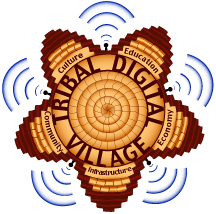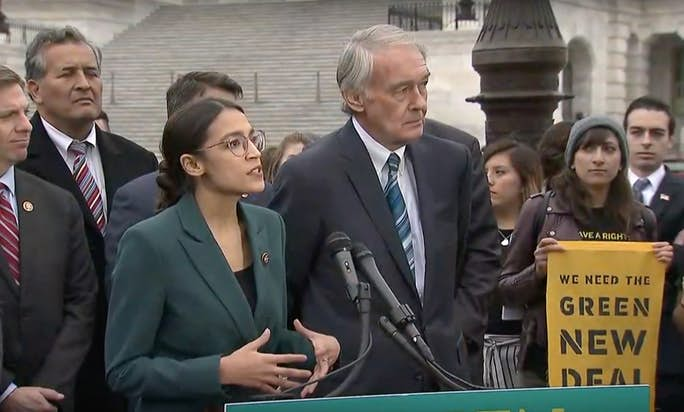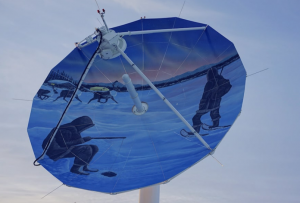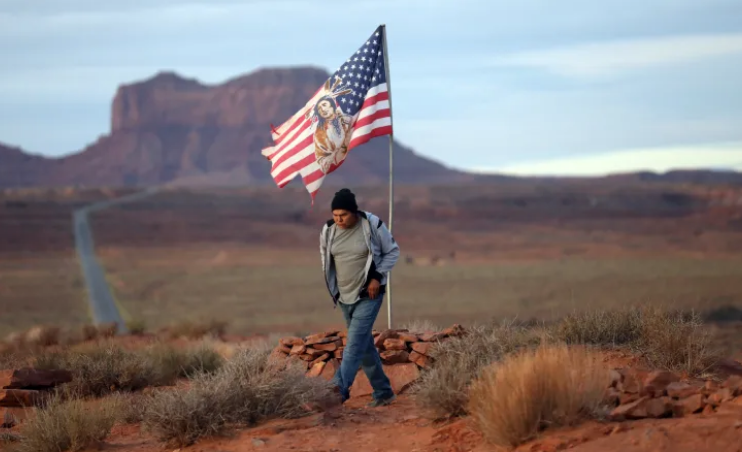Census is less than a year away; A better count is essential for Indian Country
by Jourdan Bennett-Begaye
Apr 9
The Census Bureau reported an official 12.2 percent undercount of American Indians on reservations, an undercount of 0.7 percent in 2000, and a 4.9 percent in 2010
A popular meme shows a gathering of Native Americans on the shore with a ship approaching followed by the punch line: “1491 Census: Population 100 percent Native American.”
The Native American Rights Fund, the meme creator, and other tribal organizations shared the drawing plus the message, “If we aren’t counted, the joke is on us.”
We are now less than a year away until the 2020 Census Day. And there is even less time for some communities in Indian Country. The first official count will take place in Tooksook Bay, Alaska, in January.
So the bureau is busy hiring people now within their own communities, said Tim Olson, associate director for field operations of the U.S. Census Bureau, at a Census Bureau press briefing in Washington, D.C. Employees will be paid $13.50 to $30 per hour depending on the location.
This is critical for tribal communities because Native American and Alaskan Native communities have been historically undercounted. So hiring people from the actual communities they are familiar with could help produce a more accurate count.
Every 10 years the Census Bureau counts every person in the United States. At least that’s the plan, a Constitutional requirement. But for Indian Country it’s often a question of how large the undercount will be.
This will be the 24th census over a span of 220 years, that includes 45 presidents, 58 presidential elections, and 116 Congresses, according to University of Wisconsin Professor Margo Anderson. Even the Civil War didn’t stop the count from happening.
In fact, the decennial census is required by the U.S. Constitution in Article 1, section 2. Those who wrote the Constitution wanted to give the people power in their government. They wanted the number of representatives in Congress to reflect the country’s population.
It was also a way for the lawmakers, back then, to promote expansion, when settlers started encroaching on tribal lands.
The data is used to determine the boundaries for congressional districts. And the boundaries for state legislative districts. Those count is used to draw lines that then determine the power of a vote — or an undermining of that vote.
One example: Republicans in Texas, Arizona, Missouri and Nebraska want to use the next census data for redistricting with “citizens-only” districts, according to a recent report by Reuters.
But any questions about citizenship remain a contentious issue that will be decided by the courts. President Donald Trump has tweeted that the census will be “meaningless” unless it includes a question about citizenship. But, as The New York Times pointed out, “Trump’s disdain for conducting the once-a-decade census without a citizenship question is not shared by his own Census Bureau researchers. Nor is it consistent with the many operations of government and business that make billions of dollars in spending decisions as well as policy decisions based on the most accurate possible count of the U.S. population.”
Current federal law prohibits a separation of the population into a “citizens-only district” for the U.S. House. Those seats must reflect the total population. However, state legislative redistricting might be determined using other data.
Professor Albert Kauffman told Reuters that “redrawing such districts with citizen-only populations would give Republicans a better shot by expanding the districts into more conservative areas.”
This is gerrymandering, an old practice, which is “arranging a territorial unit into election districts in a way that gives one political party an unfair advantage in elections.”
Cases of gerrymandering come up around every decennial census.
Another use of the data is drawing a school district boundary.
The numbers from the census also influence how programs are funded.
Lt. Gov. Peggy Flanagan, White Earth, explained this in a tweet last week.
“Census data is how public officials make decisions about how money is spent, which communities are invested in, and really how we plan for the future,” she said.
To put it in short, this data determines how $675 billion of federal funding is distributed, which communities needs attention and resources from the government and private sectors, and everything in between for schools, housing, Indian Health Service, and business investments.
These resources affects communities who have historically been undercounted, such as Native American and Alaskan Native communities, are at risk for receiving little resources if the census is inaccurate. They are part of the “hard-to-count” population along with other groups who have been underrepresented in the census in the past, such as children ages 0 to 5.
(HARD TO COUNT MAP: https://www.censushardtocountmaps2020.us/)
Chickasaw Nation Governor Bill Anoatubby, who spoke at the census press briefing, said tribes need to reach out to and encourage their tribal citizens to participate in the 2020 Census.
“According to the 2010 Census, roughly 26 percent of Native Americans live hard-to-count census tracts,” he said during a Census Bureau press briefing at the National Press Club in Washington, D.C.
American Indians and Alaska Native populations were undercounted at 4.9 percent in the 2010 Census due to “logistical obstacles,” said Gov. Anoatubby. That’s more than double next to the closest population group.
He’s right.
Look at the census data from 1990. There was a 12.2 percent undercount of American Indians on the reservations, an undercount of 0.7 percent in 2000, and a 4.9 percent in 2010.
Undercount of the American Indian and Alaska Native population in the 1990, 2000, and 2010 Census.
Undercount of the American Indian and Alaska Native population in the 1990, 2000, and 2010 Census.(Graph by the National Congress of American Indians)
The numbers fluctuated for American Indians and Alaskan Natives living off the reservations during the three censuses. In 1990, there was an overcount of 0.9 percent, an undercount of 0.6 percent in 2000, and a 2 percent undercount in 2010.
However, Anoatubby believes that the Census Bureau establishing three methods to participating in the census will help give Indian Country a more accurate count. Everyone can respond to the census in one of three ways: mail, phone, or online.
Technology may contribute to getting those numbers right. (Yes, the bureau knows there is no WiFi in areas and prepared for that. Their devices will work offline.)
Considering the history of how Native people were counted in the last 220 years, this is a huge step up.
Technically, Native people weren’t supposed to be included in the census count per the Constitution when it stated “Indians not taxed.” This meant Indians living on reservations or in unsettled areas of the country.
So even though the census started in 1790, the first census record of a Native person was in 1860, according to the National Archives.
Even then the census was unreliable. Not all Pueblos were included. If they were, they were were recorded as non-White. Taos Pueblos were enumerated as “copper” and “Indian.” Those census takers were the ones to determine your race unlike now where the bureau allows people to self-identify.
This is where the changes come in.
Again, technology improves the process of a self-response census, which the bureau says, will give a more accurate count.
For one, the bureau is taking the approach that they are trying to reach the hard-to-count populations first.
The bureau worked with more tribal organizations at a national, regional and local level, including tribal governments. Organizations include the National Congress of American Indians and the Alaska Federation of Natives.
A Census Bureau official at the Washington press briefing said they consulted with tribal governments 19 times in the past two years. Tribal leaders told the bureau the best ways they could reach out to their tribal citizens for self-responses.
Another improvement is the expansion of tribal names to the questionnaire. English and traditional names of tribes will be taken. For example, Hopi used to be part of the “Pueblo” tribal grouping and now it’s separate.
The census hasn’t been a friendly process for Indian Country, but as many tribal organizations put it on social media, “If we don’t get counted, the joke is on us.”
Jourdan Bennett-Begaye, Diné, is a reporter/producer for Indian Country Today in Washington, D.C. Follow her on Twitter: @jourdanbb. Email: jbennett-begaye@indiancountrytoday.com





Comments are closed here.